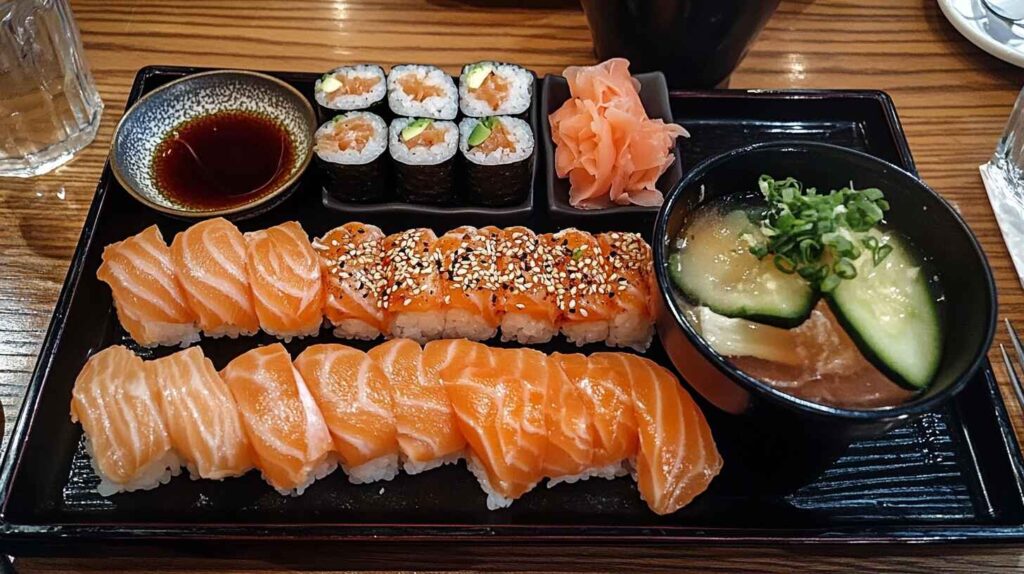
If you’ve ever had the pleasure of tasting sashimi salmon, you know it’s a dish that’s both simple and luxurious at the same time. Thin slices of raw salmon, fresh as the ocean breeze, served with a touch of soy sauce, a dab of wasabi, and maybe a slice of pickled ginger. It’s a dish that screams elegance but is surprisingly easy to make at home—if you know what you’re doing. But what exactly is sashimi salmon, and why is it so special? Let’s dive in! 🐟
Table of Contents
What is Sashimi Salmon?
Sashimi salmon is a Japanese delicacy made from thinly sliced, raw salmon. Unlike sushi, which often includes vinegared rice, sashimi is all about the fish. It’s a celebration of the salmon’s natural flavor, texture, and freshness. Think of it as the fish’s time to shine, without any distractions.
“Sashimi is not just food; it’s an art form. Every slice tells a story of the sea.” – Anonymous Sushi Chef
But why salmon? Well, salmon is one of the most popular fish for sashimi because of its rich, buttery texture and mild flavor. It’s like the avocado of the seafood world—versatile, delicious, and loved by almost everyone.
The Origins of Sashimi
Sashimi has been a part of Japanese cuisine for centuries. The word “sashimi” literally means “pierced body,” which refers to the traditional method of preparing the fish. Back in the day, fishermen would spear the fish and slice it fresh for immediate consumption. Talk about fresh seafood! 🎣
Over time, sashimi evolved into the delicate, artfully presented dish we know today. It’s not just about eating raw fish; it’s about appreciating the craftsmanship that goes into selecting, preparing, and serving it.
Why Salmon is Perfect for Sashimi
So, why is salmon such a star in the sashimi world? Here’s the scoop:
- Rich Flavor: Salmon has a naturally buttery, slightly sweet flavor that pairs perfectly with soy sauce and wasabi.
- Soft Texture: Its tender, melt-in-your-mouth texture makes it a joy to eat.
- Nutritional Powerhouse: Packed with omega-3 fatty acids, protein, and vitamins, salmon is as healthy as it is delicious.
But not all salmon is created equal. To make the best sashimi, you need the best salmon. And that brings us to our next point.
How to Choose the Best Salmon for Sashimi
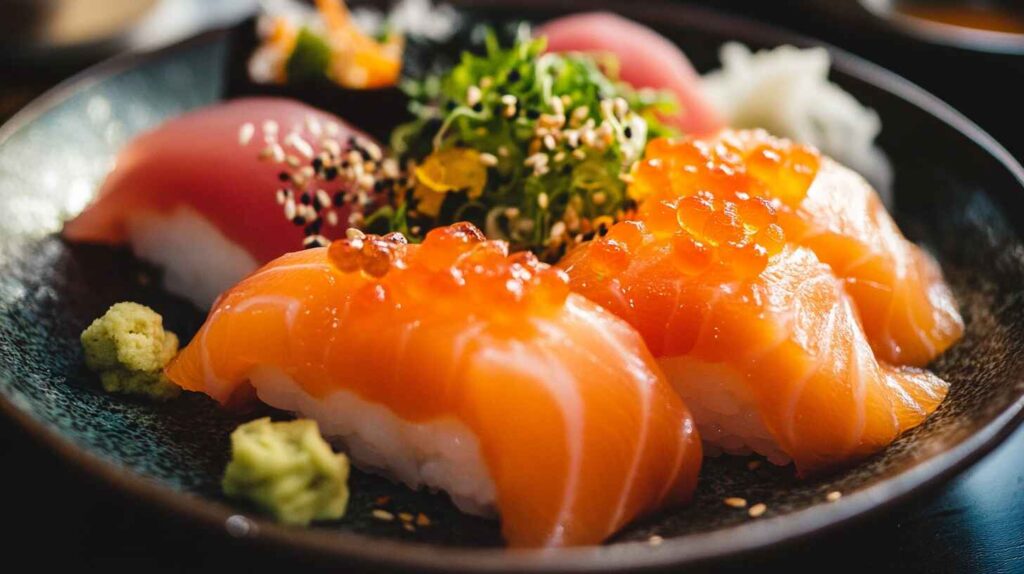
Choosing the right salmon for sashimi is like picking the perfect avocado—it’s all about freshness and quality. Here’s what you need to know:
Freshness is Key
When it comes to sashimi, freshness isn’t just important—it’s everything. Fresh salmon should have a bright, vibrant color (think deep orange or pink) and a clean, ocean-like smell. If it smells fishy or looks dull, it’s a no-go. 🚫
Pro tip: Ask your fishmonger when the salmon was delivered. The fresher, the better!
Wild vs. Farmed Salmon: Which is Better?
This is a hot debate in the seafood world. Wild salmon is caught in its natural habitat, while farmed salmon is raised in controlled environments. Here’s the breakdown:
| Type | Pros | Cons |
|---|---|---|
| Wild Salmon | Rich flavor, natural diet, fewer additives | More expensive, seasonal availability |
| Farmed Salmon | Affordable, available year-round | May contain antibiotics, less intense flavor |
Both can be used for sashimi, but wild salmon is often preferred for its superior taste and texture.
Understanding Sashimi-Grade Salmon
Not all salmon is safe to eat raw. Sashimi-grade salmon is specially handled and frozen to kill any parasites, making it safe for raw consumption. Always look for the “sashimi-grade” label when buying salmon for sashimi.
The Health Benefits of Sashimi Salmon
Now that we’ve covered the basics, let’s talk about why sashimi salmon is not just delicious but also incredibly good for you.
Rich in Omega-3 Fatty Acids
Omega-3s are essential fats that your body can’t produce on its own. They’re great for your heart, brain, and overall health. And guess what? Salmon is one of the best sources of omega-3s out there. 🧠❤️
High-Quality Protein Source
Protein is the building block of life, and salmon is packed with it. A single serving of sashimi salmon can give you a hefty dose of high-quality protein, helping you build muscle and stay full longer.
Low in Calories, High in Nutrients
Sashimi salmon is a low-calorie food that’s rich in vitamins and minerals like vitamin D, B12, and selenium. It’s the perfect choice for anyone looking to eat healthy without sacrificing flavor.
Nutrition Facts Table
Here’s a quick look at the nutritional profile of sashimi salmon (per 100g serving):
| Nutrient | Amount |
|---|---|
| Calories | 208 kcal |
| Protein | 20g |
| Fat | 13g |
| Omega-3 Fatty Acids | 2.3g |
| Vitamin D | 15% DV |
| Vitamin B12 | 50% DV |
| Selenium | 45% DV |
Common Problems When Preparing Sashimi Salmon
Even though sashimi salmon seems simple, there are a few pitfalls to watch out for. Let’s tackle the most common problems and how to avoid them.
Risk of Parasites and Bacteria
Eating raw fish comes with risks, especially if the salmon isn’t handled properly. Parasites and bacteria can lurk in improperly prepared fish, leading to foodborne illnesses. Yikes! 😱
Improper Cutting Techniques
Slicing sashimi is an art. If your slices are too thick, too thin, or uneven, it can ruin the texture and presentation of your dish. Practice makes perfect!
Storing Salmon Incorrectly
Fresh salmon is delicate and can spoil quickly if not stored properly. Always keep it refrigerated and use it within a day or two of purchase.
Solutions to Sashimi Salmon Problems
Now that we’ve identified the common problems when preparing sashimi salmon, let’s talk about how to solve them. After all, nobody wants a sushi night to turn into a food poisoning nightmare, right? 😅
How to Ensure Salmon is Safe to Eat Raw
The biggest concern with sashimi is safety. Raw fish can carry parasites or bacteria, but there are ways to minimize the risk:
- Buy Sashimi-Grade Salmon: Always opt for salmon labeled “sashimi-grade” or “sushi-grade.” This means the fish has been frozen at temperatures low enough to kill parasites.
- Freeze It Yourself: If you can’t find sashimi-grade salmon, you can freeze it at home. The FDA recommends freezing fish at -4°F (-20°C) for at least 7 days to kill parasites.
- Inspect the Fish: Look for bright, firm flesh and a fresh, ocean-like smell. If it smells off or looks slimy, don’t risk it.
“When it comes to raw fish, trust your senses. If something feels off, it probably is.” – A Wise Fishmonger
Mastering the Art of Slicing Salmon
Slicing sashimi is like playing a musical instrument—it takes practice, precision, and the right tools. Here’s how to get it right:
- Use a Sharp Knife: A dull knife will tear the flesh, ruining the texture. Invest in a good sashimi knife (or a very sharp chef’s knife).
- Cut Against the Grain: Slice the salmon at a slight angle, against the grain, to create smooth, even pieces.
- Keep It Thin: Aim for slices that are about 1/4 inch thick. Too thick, and it’ll be chewy; too thin, and it’ll fall apart.
Pro tip: Dip your knife in water between slices to prevent sticking and ensure clean cuts. 💧
Proper Storage Techniques for Sashimi Salmon
Fresh salmon is delicate, so proper storage is crucial. Here’s how to keep it fresh:
- Refrigerate Immediately: Store your salmon in the coldest part of the fridge (usually the bottom shelf) and use it within 1-2 days.
- Wrap It Right: Wrap the salmon tightly in plastic wrap or place it in an airtight container to prevent exposure to air.
- Freeze for Later: If you’re not using the salmon right away, freeze it in a vacuum-sealed bag to lock in freshness.
Step-by-Step Guide to Making Sashimi Salmon at Home
Ready to make your own sashimi salmon? Let’s break it down step by step. Don’t worry—it’s easier than you think! 🍴
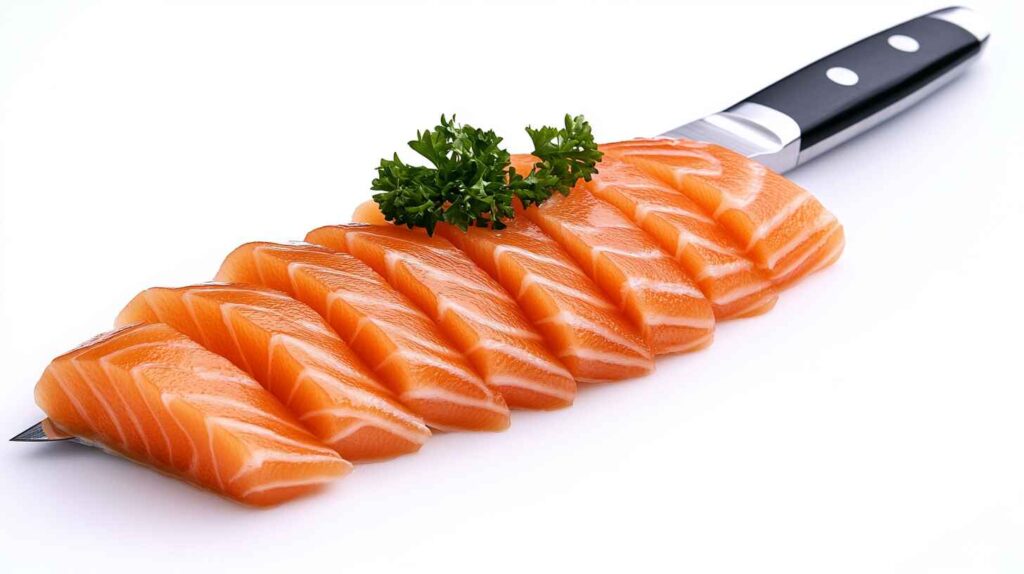
Tools You’ll Need
Before you start, make sure you have the right tools:
- A sharp sashimi or chef’s knife
- A cutting board (preferably one reserved for raw fish)
- Tweezers (for removing any stray bones)
- A clean towel or paper towels (for patting the fish dry)
Preparing the Salmon
- Inspect the Fish: Check for any bones or imperfections. Use tweezers to remove any bones you find.
- Pat It Dry: Use a clean towel or paper towels to pat the salmon dry. Excess moisture can make slicing difficult.
- Trim the Edges: If the edges are uneven or discolored, trim them off for a cleaner presentation.
Slicing the Salmon Like a Pro
- Position the Salmon: Place the salmon skin-side down on the cutting board.
- Start Slicing: Hold the knife at a slight angle and slice against the grain. Aim for thin, even slices.
- Adjust as Needed: If a slice is too thick or uneven, don’t stress—just adjust your angle and try again.
Plating and Presentation Tips
Presentation is key when it comes to sashimi. Here’s how to make your dish look as good as it tastes:
- Use a Simple Plate: A white or black plate works best to highlight the vibrant color of the salmon.
- Arrange Thoughtfully: Place the slices in a circular or fan-like pattern for a visually appealing display.
- Add Garnishes: A few sprigs of shiso leaves, a slice of lemon, or a sprinkle of sesame seeds can elevate your presentation.
Popular Sashimi Salmon Recipes to Try
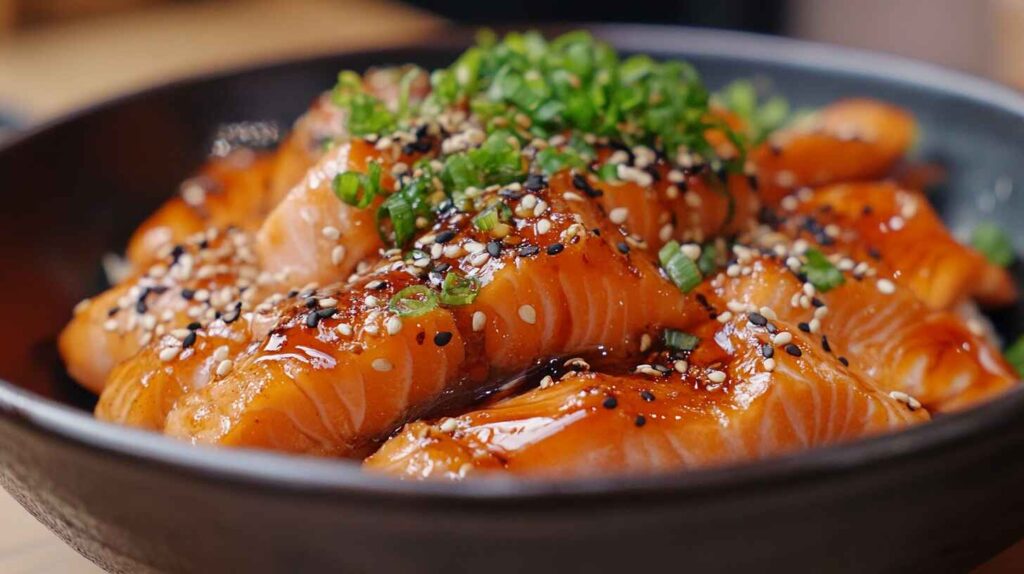
Now that you’ve mastered the basics, let’s spice things up with some delicious sashimi salmon recipes. 🍣
Classic Sashimi Salmon with Soy Sauce and Wasabi
This is the OG sashimi experience. All you need is:
- Fresh sashimi-grade salmon
- Soy sauce
- Wasabi
- Pickled ginger
Slice the salmon, arrange it on a plate, and serve with small dishes of soy sauce, wasabi, and ginger. Dip, eat, and enjoy!
Spicy Salmon Sashimi Bowl
For those who like a little kick, this recipe is for you:
| Ingredients | Quantities |
|---|---|
| Sashimi-grade salmon | 200g |
| Cooked sushi rice | 1 cup |
| Sriracha | 1 tbsp |
| Mayonnaise | 1 tbsp |
| Sesame seeds | 1 tsp |
| Green onions (chopped) | 1 tbsp |
- Slice the salmon into bite-sized pieces.
- Mix sriracha and mayonnaise to create a spicy sauce.
- Layer the rice in a bowl, top with salmon, drizzle with the sauce, and sprinkle with sesame seeds and green onions.
Salmon Sashimi with Citrus Ponzu Sauce
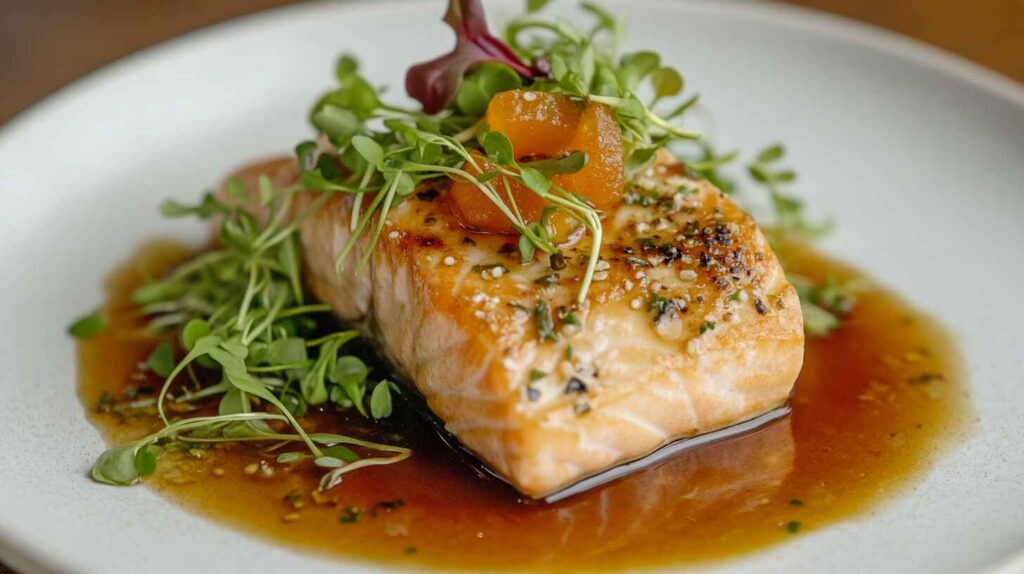
This refreshing recipe is perfect for summer:
| Ingredients | Quantities |
|---|---|
| Sashimi-grade salmon | 200g |
| Ponzu sauce | 2 tbsp |
| Lemon zest | 1 tsp |
| Microgreens | A handful |
- Slice the salmon thinly and arrange on a plate.
- Drizzle with ponzu sauce and sprinkle with lemon zest.
- Garnish with microgreens for a fresh, zesty finish.
Pairing Sashimi Salmon with the Right Sides
Sashimi salmon is delicious on its own, but pairing it with the right sides can take your meal to the next level.
Best Japanese Sides for Sashimi
- Miso Soup: A warm, savory soup that complements the cool, fresh salmon.
- Edamame: Steamed soybeans sprinkled with sea salt make a great appetizer.
- Seaweed Salad: A tangy, refreshing side that adds a pop of color and flavor.
Wine and Sake Pairings for Sashimi Salmon
- Sake: A dry, crisp sake enhances the delicate flavor of the salmon.
- White Wine: A light, citrusy white wine like Sauvignon Blanc pairs beautifully with sashimi.
- Sparkling Water: For a non-alcoholic option, try sparkling water with a slice of lemon or lime.
Tips for Eating Sashimi Salmon Like a Pro
So, you’ve got your beautifully prepared sashimi salmon in front of you. Now what? Eating sashimi is more than just popping a piece of fish into your mouth—it’s an experience. Here’s how to do it like a pro. 🍣
How to Use Chopsticks Correctly
If you’re not a chopstick master yet, don’t worry. Here’s a quick guide:
- Hold the First Chopstick: Place the first chopstick between your thumb and index finger, resting it on your ring finger.
- Add the Second Chopstick: Hold the second chopstick like a pencil, using your thumb, index, and middle fingers.
- Practice Moving Them: Move the top chopstick up and down while keeping the bottom one steady. It’s like a pincer motion!
Pro tip: If chopsticks feel too tricky, it’s totally okay to use your hands. In Japan, eating sashimi with your fingers is actually considered polite!
The Right Way to Dip Sashimi in Soy Sauce
Dipping sashimi in soy sauce seems simple, but there’s a trick to it:
- Don’t Overdo It: A light dip is all you need. You want to taste the salmon, not drown it in soy sauce.
- Fish Side Down: Dip the fish side into the soy sauce, not the rice (if you’re having sushi). This keeps the rice from falling apart.
- Skip the Wasabi Mix: If you’re using wasabi, place a small amount directly on the sashimi instead of mixing it into the soy sauce. This preserves the flavors.
“Sashimi is about balance. Let the fish shine, and use condiments to enhance, not overpower.” – A Sushi Chef’s Wisdom
Understanding the Role of Wasabi and Ginger
Wasabi and pickled ginger aren’t just there for decoration—they serve important purposes:
- Wasabi: This spicy green paste adds a kick and has antimicrobial properties that help keep the fish safe to eat.
- Pickled Ginger: Also known as gari, it cleanses your palate between bites, allowing you to fully appreciate each piece of sashimi.
Fun fact: Real wasabi is rare and expensive. Most “wasabi” served in restaurants is actually a mix of horseradish, mustard, and food coloring. 🌱
Frequently Asked Questions About Sashimi Salmon
Let’s tackle some of the most common questions people have about sashimi salmon. Because let’s face it, raw fish can be a little intimidating if you’re new to it!
Is It Safe to Eat Raw Salmon?
Yes, but only if it’s sashimi-grade salmon. This means the fish has been frozen to kill parasites and handled with care to prevent contamination. Always buy from a trusted source and follow proper storage and preparation techniques.
Can I Use Regular Salmon for Sashimi?
Technically, you can, but it’s not recommended. Regular salmon hasn’t been handled or frozen to the same standards as sashimi-grade salmon, so it carries a higher risk of parasites and bacteria. When it comes to raw fish, it’s better to be safe than sorry.
How Long Can Sashimi Salmon Be Stored?
Fresh sashimi-grade salmon should be eaten within 1-2 days of purchase. If you need to store it longer, freeze it in a vacuum-sealed bag. Once thawed, use it immediately—don’t refreeze it.
Conclusion: Why Sashimi Salmon is a Must-Try Delicacy
Sashimi salmon is more than just a dish—it’s an experience. From the moment you select the perfect piece of fish to the first bite of buttery, melt-in-your-mouth salmon, it’s a journey that celebrates simplicity, freshness, and craftsmanship. 🎨
The Art and Science of Sashimi Salmon
Making sashimi salmon is both an art and a science. It requires precision, patience, and a deep respect for the ingredients. But the reward? A dish that’s as beautiful as it is delicious.
Final Tips for Enjoying Sashimi Salmon
- Start Simple: If you’re new to sashimi, start with classic sashimi salmon and soy sauce before experimenting with more complex recipes.
- Trust Your Senses: Freshness is key. If something looks or smells off, don’t take the risk.
- Have Fun: Don’t stress about making it perfect. Cooking (and eating) should be enjoyable!
Bonus Recipe: Salmon Sashimi Tacos
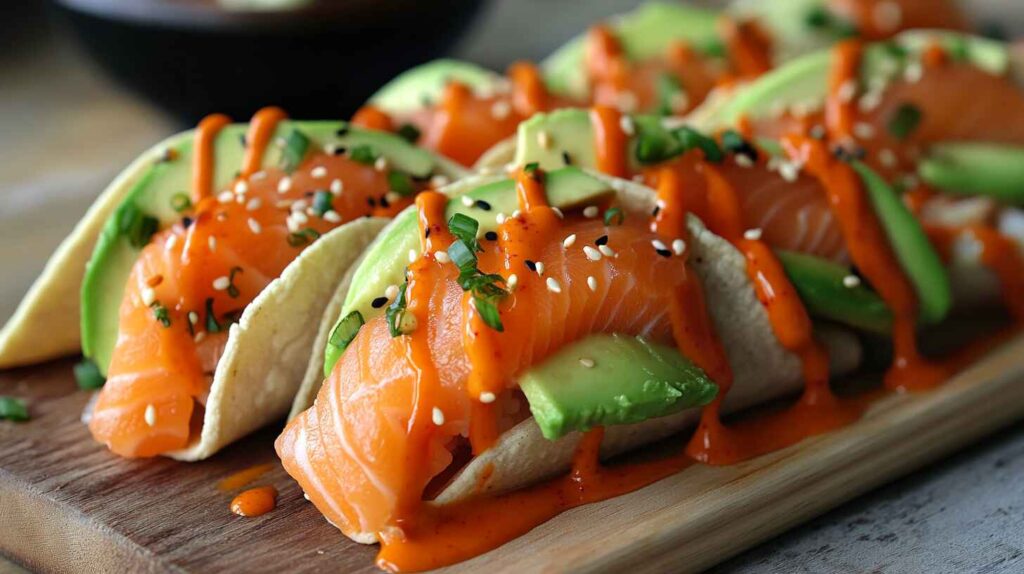
Feeling adventurous? Try this fun fusion recipe that combines sashimi salmon with Mexican flavors:
| Ingredients | Quantities |
|---|---|
| Sashimi-grade salmon | 200g |
| Small tortillas | 4 |
| Avocado (sliced) | 1 |
| Sriracha mayo | 2 tbsp |
| Lime wedges | 2 |
| Cilantro (chopped) | 1 tbsp |
- Slice the salmon into thin pieces.
- Warm the tortillas and layer with avocado slices.
- Add the salmon, drizzle with sriracha mayo, and sprinkle with cilantro.
- Serve with lime wedges for a zesty finish.
That’s a wrap on our ultimate guide to sashimi salmon! 🎉 Whether you’re a seasoned sashimi lover or a curious beginner, we hope this article has inspired you to try making sashimi salmon at home. Remember, it’s all about freshness, quality, and a little bit of practice. Happy slicing! 🍣
Classic Sashimi Salmon with Soy Sauce and Wasabi
Equipment
- Sharp sashimi or chef’s knife
- Cutting board
Ingredients
- 200 g sashimi-grade salmon
- Soy sauce
- Wasabi
- Pickled ginger
Instructions
- Inspect the fish for any bones or imperfections. Use tweezers to remove any bones you find.
- Pat the salmon dry using a clean towel or paper towels.
- Trim the edges if they are uneven or discolored.
- Place the salmon skin-side down on the cutting board.
- Slice the salmon at a slight angle against the grain into thin, even slices.
- Arrange the slices on a plate in a circular or fan-like pattern.
- Serve with small dishes of soy sauce, wasabi, and pickled ginger.

